On any given night, you can probably find me sitting on the aisle of a theatre somewhere in ╔ź╔ź└▓, with a pen in one hand and a notebook on my lap, reviewing the latest show that has opened. But if you were at the Princess of Wales Theatre last Thursday evening, you may have seen me╠řż▒▓ď╠řthe aisle instead.╠ř
I had traded my pen and notebook for grey pantaloons, a giant rhinoceros puppet and a small role in Mirvish’s production of “The Lion King.” For one night only, I joined the Pride Lands for the Disney musical’s iconic opening number, “Circle of Life.”╠ř
Joshua Chong traded in his pen and notebook for a small role in the blockbuster Disney musical, Lion King.
My performance lasted no more than three minutes, yet the experience proved transformative. I’ve seen hundreds of professional theatre productions as an audience member and a critic. Never did I imagine that I’d be in one of them. But being on the other side of the curtain was more than special. It reaffirmed my love of the theatre.╠ř

Joshua Chong, The ╔ź╔ź└▓ StarÔÇÖs arts critic and culture reporter, spends a day as part of the cast of “The Lion King.”
Nick Lachance/╔ź╔ź└▓ StarWas I nervous? You bet. It had been years since I last stepped on stage. Even then, most of my previous experience was limited to high school productions and small community shows.╠ř
I was also known to be a bit of a klutz. In the fourth grade, I played Kurt in “The Sound of Music,” in my elementary school’s Broadway-style revue showcase. At the end of “My Favorite Things,” when Maria and the von Trapp children are prancing around her bedroom, I accidentally knocked into a set piece ÔÇö hard ÔÇö and sent it crashing down on my cast mates and me. (╔ź╔ź└▓ video of that epic disaster is buried somewhere in my parents’ basement.)
In “The Lion King,” I was tasked with playing the back half of the two-person rhino puppet, which leads the procession during “Circle of Life,” walking down the right aisle, then climbing up onto the stage and weaving through a sea of other sub-Saharan animals ÔÇö from lithe cheetahs to leaping gazelles and soaring birds.╠ř
I had watched this awe-inspiring sequence on three previous occasions. As directed with boundless imagination by Julie Taymor, it’s one of the greatest opening numbers to any Broadway show. But it was easy as an audience member to let the spectacle wash over me, to take for granted what goes on to pull it all off.╠ř

Resident dance supervisor Theresa Nguyen smiles as she teaches Joshua Chong how to move like a rhino.╠ř
Nick Lachance/╔ź╔ź└▓ StarIn my two-hour rehearsal ahead of my performance, I soon learned the painstaking attention to detail that goes into that single number. Every moment, every footstep, every beat of music is carefully planned and plotted out.
Theresa Nguyen, the show’s resident dance supervisor, walked me through each bit of choreography. We ran the opening sequence at least a dozen times╠řÔÇö first in my street clothes, then incorporating the music, before finally adding the puppet and my rhino partner, Tenaj Williams.╠ř
The low bar I set for myself: Not to trip on the stairs and fall into the orchestra pit. We didn’t need another “Sound of Music”-esque mishap, this time in front of 2,000 paying audience members.╠ř
After learning╠řthe staging, I was whisked into a music rehearsal with associate conductor Joy Brown, who ran me through my vocal part, while Khaya Mniki drilled the correct Zulu pronunciations into my head. “Ingonyama nengw’ enamabala,” I’d be singing, along with the rest of the ensemble.╠ř
What surprised me the most about my entire experience, however, were not the rehearsals nor the performance itself, but what was happening out of sight of the audience, in the bowels of the theatre.╠ř

Left: Joy Brown, conductor of ÔÇťThe Lion King,ÔÇŁ rehearses the showÔÇÖs opening number with Joshua Chong. Right: Joshua Chong puts on his rhino legs.╠ř
Nick Lachance/╔ź╔ź└▓ StarIt’s astonishing to see what goes on behind the scenes at a mega-musical like “The Lion King.” This particular production features more than 50 performers. But backstage, there’s also a legion of crew, dressers, technicians, hair and makeup specialists, and stage managers ÔÇö without whom the show would come to a standstill.╠ř
(Shoutout to makeup supervisor Isaac Gryphon, assistant head of wardrobe Cathy de Grosbois and assistant stage manager Keleshaye Christmas for making this clueless critic feel like a star.)╠ř
The Princess of Wales Theatre is one of the city’s largest venues. Still, with a production of this size, every inch of space is used. Hallways are lined with costume racks and quick-change booths fill the passageway immediately behind the stage. To save space, large props and set pieces are hoisted above the wings when they aren’t being used. And everything runs like clockwork, with the activity backstage almost as choreographed as the show itself.╠ř
By 6:40 p.m., I was changed into my costume. Five minutes later, Gryphon helped to apply my makeup (more like face paint). Around me, the performers were warming up their voices. Lip trills and vocal exercises filled the air.╠ř
Even though this Canadian production of “The Lion King” has been running for more than half a year, the energy backstage still felt palpable. Company members wished each other a good show. For some, it’s with a gentle pat on the shoulder. For others, it involves pre-show ritual. (While I was waiting to get my makeup done, ensemble member Wade Buller taught me their ritual, which involves locking pinkies with another cast member, and each person biting their own thumb.)╠ř

Wade Buller and Josh Chong bite their thumbs while interlocking pinky fingers. ÔÇťI do this ritual with every member of the cast.ÔÇŁ Buller said.
Nick Lachance/╔ź╔ź└▓ StarWhen “places” was called at 6:58 p.m., the actors in the animal procession all gathered together backstage. Four minutes later, with the doors to the auditorium now closed, we made our way around the theatre and into the orchestra lobby, where we’d get into our puppets.╠ř
Williams, the front half of the rhino to my caboose, gave me a piece of advice before the show began: “When we get onto the stage, look out into the audience and take it all in.”

Joshua Chong gets into his rhino costume just before the start of the show.╠ř
Nick Lachance/╔ź╔ź└▓ StarThen, before I knew it, Zama Magudulela was onstage as Rafiki, belting out the opening notes of “Circle of Life.” Singing a cappella, we╠řjoin in, harmonies blending gorgeously. Soon, the orchestra starts to play, marking our cue to enter the auditorium.╠ř
There’s a saying in the theatre that a show is never complete without an audience; they’re the final character to any stage show. But I never truly understood what that meant until this experience with “The Lion King.”╠ř
No amount of rehearsal╠řcan prepare you for performing in front of a live crowd. Walking down the aisle, seeing the wide-eyed expressions of the children in the audiences, hearing their oohs and aahs, adds another dynamic to the show.╠ř
When Williams and I made our way onto the stage (no trips nor stumbles, fortunately), I did as he told me and looked out into the house. With the lights dimmed, I could only make out the silhouettes of audience members. But I glanced up, way up, past the dress circle and into the balcony. That was where I sat years ago, with my father and mother, to watch my first professional theatre production.
For a fleeting moment while we were centre stage, I thought about who was sitting there this particular evening.╠ř

Tenaj Williams and Joshua Chong as the rhino, walking down the aisle of the Princess of Wales Theatre
Nick Lachance/╔ź╔ź└▓ StarTheatre is ultimately about connection ÔÇö between audience and performer. At its best, it’s a feeling that’s immediate and personal. “The Lion King” ÔÇö and “Circle of Life” more specifically╠řÔÇö is one of those pieces of live theatre where that sense of connection is so apparent and so powerful.
I’ve felt it countless times whenever I’ve seen this show as an audience member. But being on the other side of it made me better appreciate how that connection is forged ÔÇö with dedication, care and love.
It reminded me why I love this art form in the first place.╠ř
“The Lion King” runs until Aug. 30 at the Princess of Wales Theatre, 300 King St. W. Visit for tickets and more information.

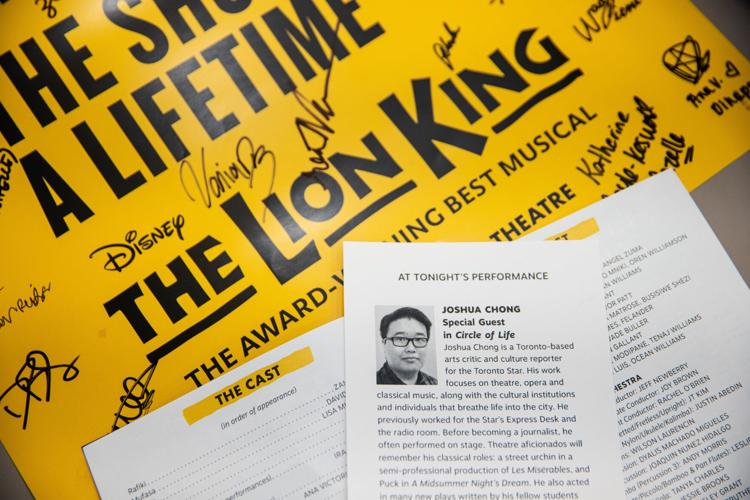

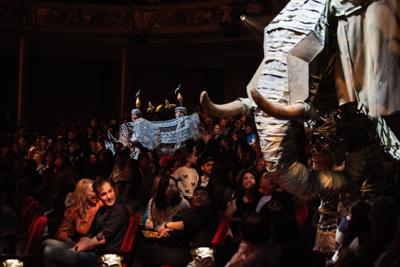
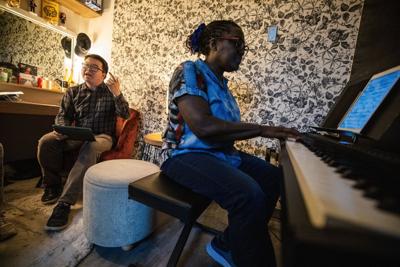
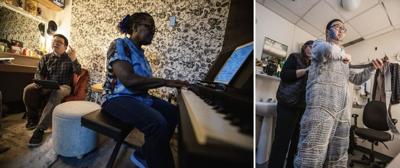
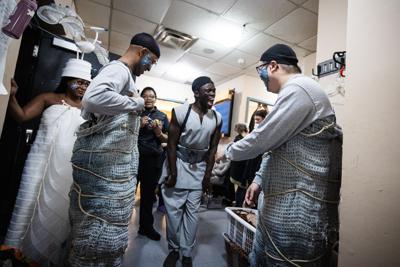
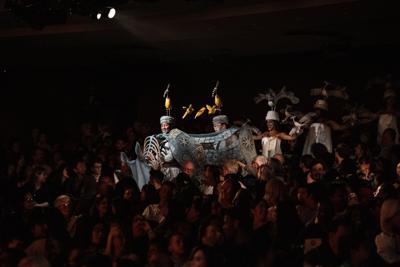
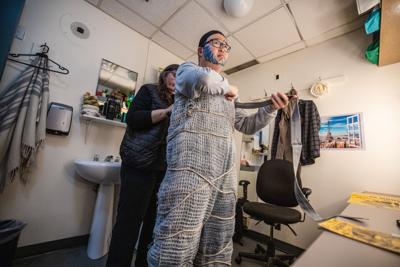





























To join the conversation set a first and last name in your user profile.
Sign in or register for free to join the Conversation